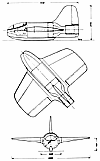Lippisch Lippisch P 01-116
Again, two versions of the one design seem to have been produced under the same
designation. Curiously, the first P.01-116 preceded the P.01-111 by over six months, the design being dated April 13, 1939. Lippisch and his design team were reluctant to be tied
exclusively to rocket-powered aircraft, as the technology was very new and untested. So they designed a series of turbojet powered aircraft. An experimental tailless aircraft with
extremely stubby, squared-off wings, the 116 had a flattened nose. The cockpit canopy followed the contours of the fuselage and was located in the extreme nose. Wing span was 19 ft 8 in (6.0 m) and length 17 ft 8 in (5.40 m).
The second P.01-116 version, dated June 12, 1941, represented a clear step along the road towards the final Me 163 Komet shape. The aircraft was tailless and the mid-set wings were swept back at 35° at the leading edge. The single-seat cockpit was of conventional layout and located behind a short nose. The dual powerplant comprised a single 1,764 lb (800 kg) st BMW turbojet positioned in the belly - the air intake was just below the cockpit and the jet pipe two-thirds of the way along the lower fuselage - and a 660-3,307 1b (300 -1,500 kg) thrust BMW 109-510 variable-thrust rocket motor located in the rear fuselage above the turbojet exhaust. Armament was to be two 20 mm cannon and two 13 mm machine guns, and wing span was 29 ft 6 in (8.90 m) and length 23 ft (7.0 m).
|
|||||||


